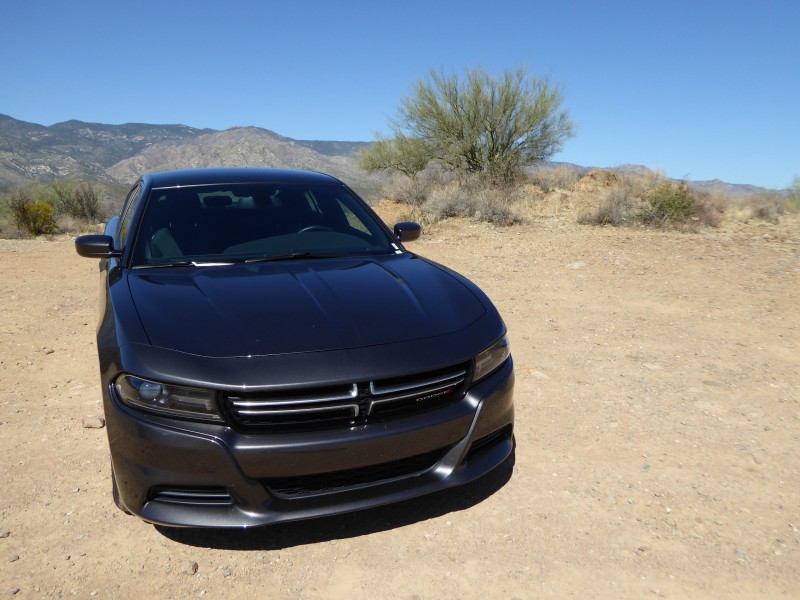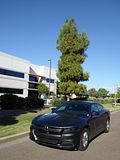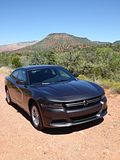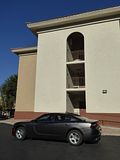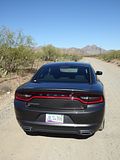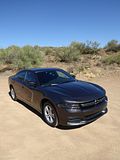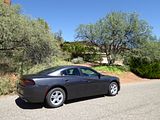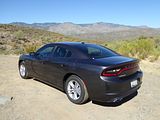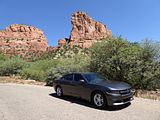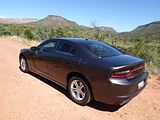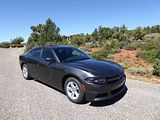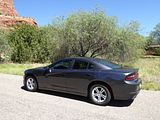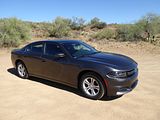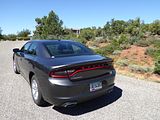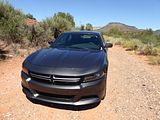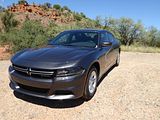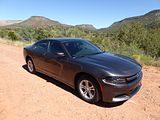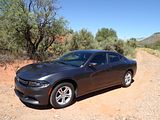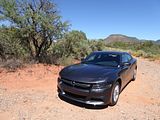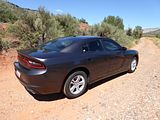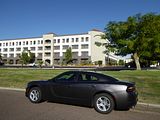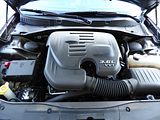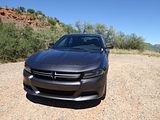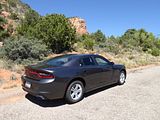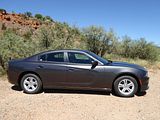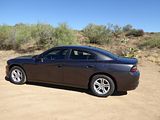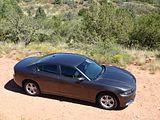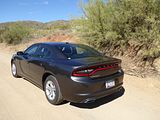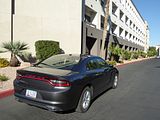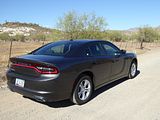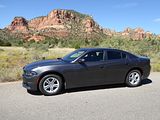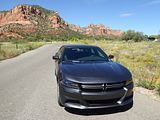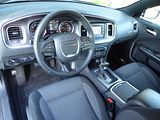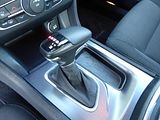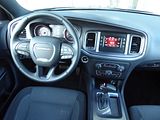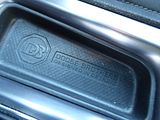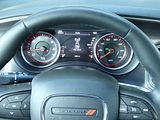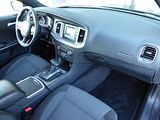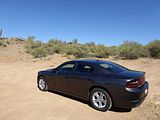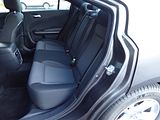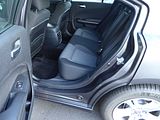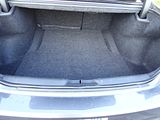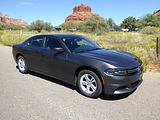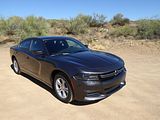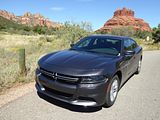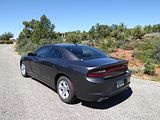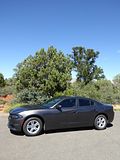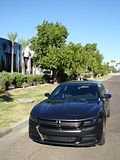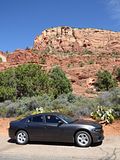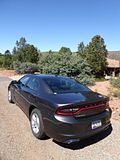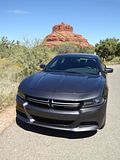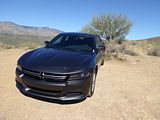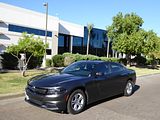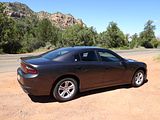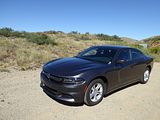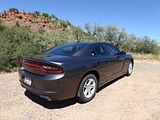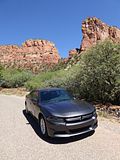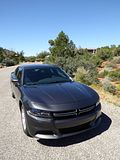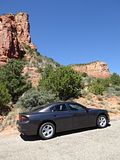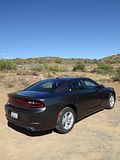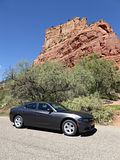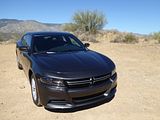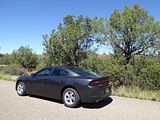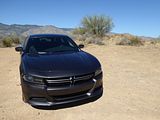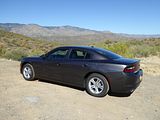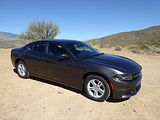
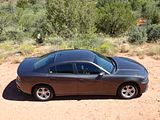
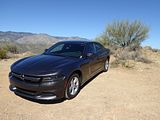
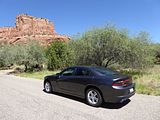
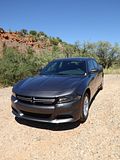
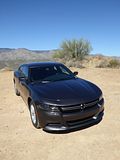
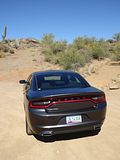
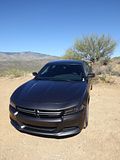
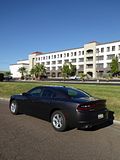
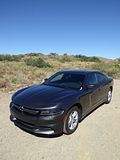
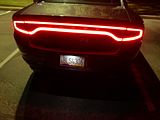

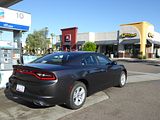
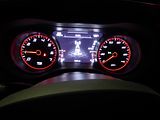
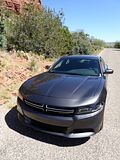
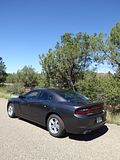


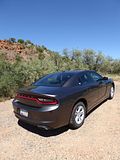
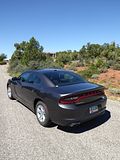
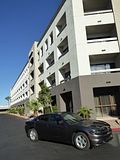
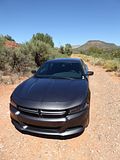
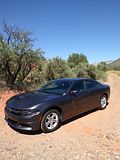
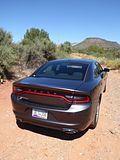
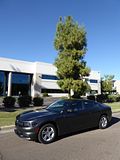
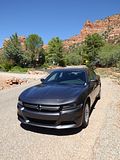

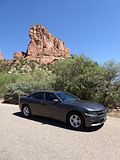
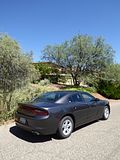
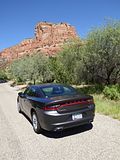
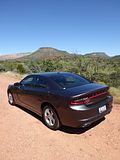
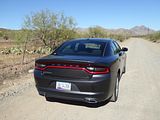
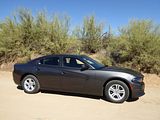
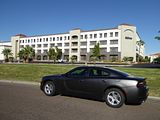

By the time I was behind the wheel of that 2014 car, though, in September 2014, a substantial makeover had already been announced, though not at the time yet on sale. This update had been announced at the 2014 New York Auto Show in April of that year. The most noticeable changes were at the front, with a new grille and rounded LED headlights. In fact, Dodge claimed to have reworked just about every panel on the car; in an effort not just to modernise, but to make it look, in their words, leaner and more athletic than previously, while keeping the same dimensions. The interior was given a refresh, too, with new materials for the door, console and dash panels, a new steering wheel and seats, and a wide range of trim packages with both leather and cloth seating. The 2015 Charger also features a new instrument cluster featuring a 7″ TFT (Thin Film Transistor) instrument display. The UConnect touchscreen audio and infotainment system was revised to include UConnect Apps. Mechanically, the 3.6 litre Pentastar V6 and the 5.7 and 6.4 litre V8 Hemi engines remained the same, but the ZF 8-speed automatic transmissions that had previously only been coupled with the V6 engine was standardised across the range. There were revisions to the chassis components, including Electric Assist Power Steering, replacing the previous model’s Electro-Hydraulic Assist Power Steering, and new aluminium rear differential had 4 mounting bolts for rigidity. Still a rear wheel drive car, AWD remains an option. I think the new look is particularly striking, and given how much the 2013 car had impressed me, was keen to get behind the wheel of the 2015 model. Although still few and far between in Los Angeles, Hertz in Phoenix clearly bought quite a number of the model in the spring, just around the time of my last visit, so this time, September 2015, it was not hard to source one. Indeed, Hertz kindly allocated one to me, without me even asking. They must have read my mind!
The Charger is available in a range mostly, of quite sober colours, so whilst I would have preferred one that was more photographically friendly than this Granite Crystal CIearcoat Metallic painted example, and I would also have liked one of the SXT spec cars as opposed to the base SE that had been allocated to me, I was still eager to see what improvements had been made and to check that none of the good points had gone away. Summary: They have not.
The good part starts when you get in and fire the engine. Even on the entry level SE model, you get keyless starting, so as long as the key is in proximity, you just press the large Start button to the right of the wheel. The sound of that 292 bhp V6 litre engine as it burst into life is just so much more satisfying than any of the 4 cylinders car that a rental customer would be getting for the same money. Although the Charger is bigger than those other cars, with around 100 bhp more than the most potent of them, it goes well. Very well. This is a refined engine, with a nice roar to the exhaust system if you put your foot down moderately. Otherwise, it just pulls. Although the gearlever looks similar to the old model, that slightly unusual operation has gone, and it now works utterly conventionally, so you put it in D and let those 8 ZF speeds work it out, which they do extremely well. Gearchanges are utterly seamless, meaning that there is just a smooth surge of power on accelerating or an equally smooth retardation as you reduce your speed. The Dodge never seemed to be in anything other than the right gear for the moment. When I set off, I noticed that the range for the fuel tank was showing as 553 miles, which struck me as a lot, even allowing for the large 18.5 gallon tank. At the end of my day with the Charger, I had covered 285 miles and the fuel needle was still showing 2/3rds of a tank. I put in 9.55 gallons to fill the Dodge up, which computes to 29.84 mpg US or an astonishing 35.65 mpg US. This is no one-off, as I note that I achieved nearly the same result from the 2014 model, so it would seem that the combination of a powerful engine and an effective gearbox can yield really good results.
The good news does not stop there. There is a chunky steering wheel, wrapped with good quality leather which proved particularly agreeable to hold. The 2015 model may have gone to all electric set up for steering assistance, but it does not seem to have robbed the Charger of the feel that was so evident in that 2013 car, as in this one it is also very good, and such a marked contrast to the Toyota models that I had been driving for the days prior to this test. You had a really good indication of exactly what the steered wheels were going to do, from a feelsome setup which had no trace of stickiness or over-assistance. Of course the driven wheels in this car are at the back (AWD is available, but not fitted to the test car). You’d have to drive like a hooligan, which on public roads is not recommended, to find the limits of grip or adhesion, but suffice to say that this was a fun car to take on the less than straight roads, as it went round the curves very neatly, with minimal roll, and the sensation that if you swallowed a brave pill and the Arizona State Police were not looking, you could do it all an awful lot faster without coming to grief. There is no penalty to be paid with ride quality, either, This is a very comfortable car on all the different surfaces that I encountered during my time with it, so combine this composed ride with the low noise levels and it is an effortless cruiser that could whisk you across an entire State quite easily. When it comes to time to stop, then there are well judged brakes which work with a nice even pedal pressure. There is a foot operated parking brake, in the American tradition. The Charger is quite high-waisted, and the windows are not that deep, and with a wide C pillar, you might fear that visibility would be a problem, but thanks to generously sized door mirrors, I did not find it that hard to manoeuvre the Dodge to where I wanted it to be.
The last Charger I sampled impressed as much for the quality of its interior as for everything else. And that is not something which had traditionally been said about Chrysler Corp products, all of which until very recently looked and felt particularly cheap, and in Dodge’s case, with straight edged design of the dash accentuating the problem. One of the first changes that Marchionne instigated across the entire US lineup was to improve the interiors. In some cases this was simply with less cheap quality plastics, but where there was a new model, such as the 2011 Charger, then it was possible to design something that looked and felt far more sophisticated. I concluded that it was not quite to Audi levels of quality, but not far off. The same basic design has been carried forward on the 2015 model, but the materials have been upgraded still further and there are some detailed changes to the instruments and the UConnect infotainment system. The result is that this really does feel significantly better than any of the rivals, whether they are the rental group rivals or similar sized cars like the Taurus and Maxima. There is a large single piece moulding on the dash which extends from the area right in front of the driver to the middle of the car, to encompass the central air vents and UConnect system all as a single integrated piece of design. The main dash moulding itself is formed of a nicely grained and soft touch black plastic and there is an inlay on the face surrounding the instruments and other controls in a dark gunmetal colour, with judicious use of chrome highlighter rings. Red background lighting features as it did on the old model, and the overall effect is classy. The instrument cluster contains just two dials, a rev counter and a speedometer, with smaller water temperature and fuel level gauges inset in the bottom of the larger dials. The graphics are particularly clear and unfussy, proving easy to read. Between them is a digital display area, and you can select what is presented in his by using the selector buttons on the left hand steering wheel spoke. They allow you to see all sorts of things from a digital representation of your speed, which you can convert to km/h by pressing one of the buttons, trip averages for speed and fuel consumption, various vehicle status displays such as the temperature of the oil, or what the audio unit is tuned to. There is only one column stalk, on the left of the wheel, which does indicators, and by twisting the end of it, the wipers. Lights are operated by a rotary dial on the dash to the left of the wheel. The centre of the dash contains the standard 4.3″ colour uConnect display unit, which is touch sensitive, meaning that you can select audio channels and wavebands, including satellite radio from this, rather than the array of knobs and buttons that are sported by some cars. It also has plenty of other functions including many of the climate control settings, the seat heaters and a lot of vehicle info and configuration options. Unlike some systems of its type, it was very easy to use, and extremely intuitive. Beneath it are a very simplified set of audio controls and just two dials for the dual zone climate control. As with an increasing number of cars, there is a keyless ignition system, with a Start Engine button to the right of the wheel, so as long as the key is in the vicinity, the car will fire. This is always convenient when hopping in and out whilst doing photos of any test car. The centre console contains just the new gearlever and a small coin tray, which, in a nice touch, has Dodge branding moulded into the rubber that lines it. The steering wheel design has been changed, too. A lot of buttons are incorporated into it, for audio unit repeater functions and cruise control, but it neither looks nor feels fussy.
The seats were covered in a cord like trim which was pleasant to the touch and looked more durable than materials that I often encounter. Adjustment fore/aft and for the seat height is electric, with a manual adjustment of the backrest angle. The seats themselves proved very comfortable. The column adjusts up/down and in/out, so the perfect driving position was easily found. The Charger is a full-sized car, and that really shows when you look at the amount of space inside. The rear seat is very roomy, though with a sizeable transmission tunnel and a front centre console that comes well back, a middle seat occupant would have to sit with legs astride this, which may not be that comfortable. Leg room is very generous, even with the front seats set well back. The almost Coupe like styling made me wonder about rear headroom, but actually there is no problem thanks to the rake of the backseat, though occupants will find that their head is below the massive rear window rather than under the metal of the roof. There is a central drop down armrest, which has two cupholders in its upper face. The boot is a good size, too, long from front to back, deep and wide, and the space can be extended by pulling the asymmetrically split rear seat backrests forward. There’s not a lot of space under the boot floor for extra bits and pieces, as the space saver tyre and battery occupy most of what is there. Inside the cabin, there is a split level glove box, a deep cubby under the central armrest, a small recess in front of the gear lever and bins in all four doors. Rear seat passengers get map pockets in the back of both front seats.
Dodge changed the model line up slightly for the 2015 cars. V6 models come in $27,995 SE and $29,995 SXT trim, with a choice of rear or for an extra $3000, all-wheel drive. Next up are the rear wheel drive only R/T and R/T Road and Track which have a 370 bhp 5.7 litre V8 Hemi engine. Sitting above this are two 6.4 litre cars which dust off names from the 1960s, the R/T Scat Pack and the SRT392. These have 485 bhp, and at the very top of the tree is the completely bonkers 707 bhp SRT Hellcat. Many of the features that were on the old SXT have now been applied to the SE, so the spec includes 17″ alloys, the keyless start, leather wrapped steering wheel, and a power adjustable driver’s seat. UConnect system with 5″ touch sensitive colour screen, AM/FM radio, CD, MP3, USB and AUX ports, Bluetooth, 6 speakers, wheel mounted controls and various in-car information displays, bi-function halogen projector headlights with auto sensing, heated washer nozzles, dual chrome tipped exhaust pipes, dual zone air conditioning, cruise control and split folding rear seats. The SXT adds in a wider choice of colours both for the exterior paint and the interior trim, 18″ alloys, a gloss black front grille, what Dodge call “Hectic Mesh” inlay trim for the dashboard, cloth trimmed sports seats, heated mirrors, a heated driver’s seat, an auto dimming rear view mirror, LED illuminated map pockets, an upgraded UConnect system with an 8.4″ touch sensitive colour display, premium sound, including XM Satellite radio and upgraded speakers, fully automated climate control, LED front foglights, a universal garage door opener, As well as the more powerful engine, the R/T trim brings with it sports suspension. 20″ satin carbon finished alloys, a performance exhaust system, a rear spoiler, steering wheel mounted gear paddles, Alcantara Suede and leather seat trim, and a few other minor trim embellishments. The R/T Road and Track is $36,995. It adds a memory for the radio, seats and mirrors, an 8-war power adjustable seat for driver and passenger, rear seat heating, power adjustable pedals, polished 20″ aluminium wheels with black pockets, but strangely it does not have the lights for the boot or glovebox, or front reading map lights and it loses the 12 volt power outlet sockets that feature in all other models. Another $3000 will get you into the R/T Scat Pack, the first of the models with the 6.4 litre Hemi. You also get uprated performance disc brakes all round, and SuperDuty cooling, red brake calipers, an oil cooler, what is described as a functional air scoop on the bonnet, a bright finish to the pedals. Some of the items on the Road and Track model are not included here, presumably to keep the entry price down, so you get cloth seats, for instance, and seat heating is an option. It is the first model in the range to feature an alarm and a rear-view camera. The SRT 392 retails at $47,995, and for this you get the larger 6.4 litre Hemi, a combination of Suede and Nappa leather for the seat trim, and a number of other detailed styling and equipment changes over the lesser models. The Hellcat lists at $63,995, which sounds like a lot of money, but then you are getting a 707 bhp supercharged 6.2 litre V8 powerplant, and no other 4 door saloon car comes close to that, even for more money. Most of the equipment levels are the same as the cheaper models, though you do get distinctive matt black 20″ alloys as another clue that this is the Top Dog of Charger models.
My expectations for this Charger were very high. I was not disappointed. I have always been a fan of the looks of the models bearing the name, but certainly in the case of the first generation car, I had to accept that there were better rivals on the market, even though the first generation 3.5 litre SXT that I drove back in 2010 was far from a bad car. The second generation 2014 car really hit the spot, and this one is even better. I remain very much a fan of the appearance of the cars produced between 2011 and 2014, but to my eyes, the new front end is even better. The LED front headlights on the more expensive models are a really cool addition to match those incredible full width tail lights that make this just as distinctive a design in the dark as it is in the daylight., But it is not just in the looks department where the Charger scores. It is really good to drive. The V6 engine really is a (Penta) Star and the 8 speed transmission adds to the experience. It steers and handles well, and it proved impressively economical. The interior is probably the nicest in any non-premium badged saloon car I’ve come across, and it scores just as well on usability as it does on quality and appearance. The Charger is roomy and it is comfortable. Pretty much the perfect large family car, then? I would say so. Though given the option of trying one with the V8 Hemi under the bonnet, I would expect it would not just hit my proverbial spot, but blast if forward straight into paradise. Please, Mr Hertz go and buy some!

